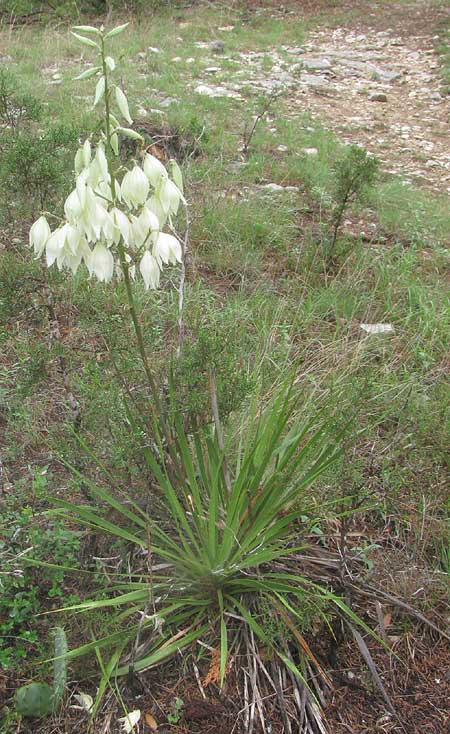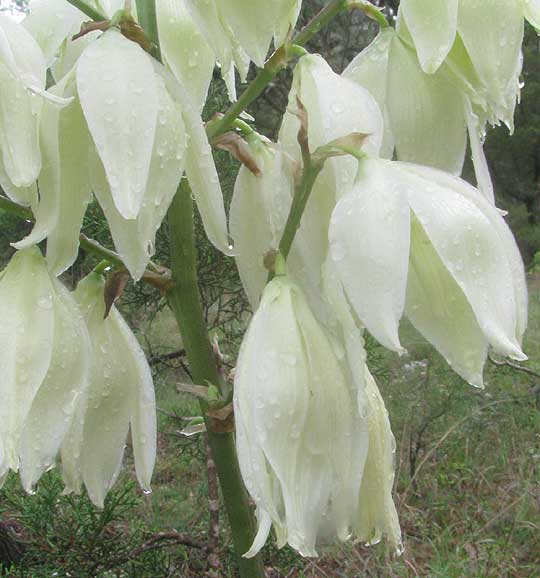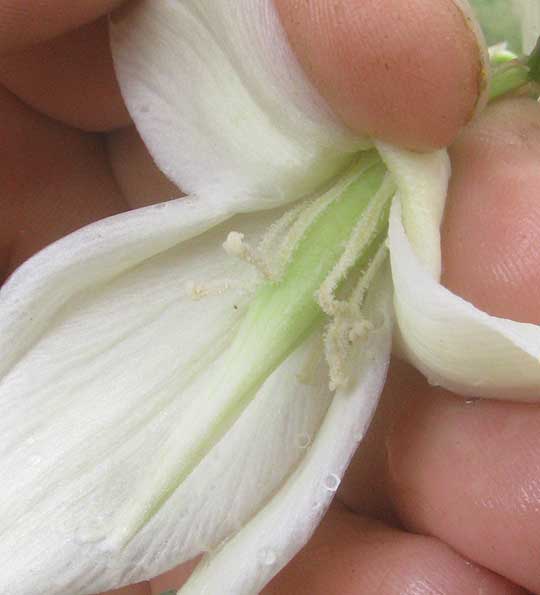Excerpts from Jim Conrad's
Naturalist Newsletter
from the June 9, 2013 Newsletter issued from the Frio Canyon Nature Education Center in northern Uvalde County, southwestern Texas, on the southern border of the Edwards Plateau; elevation ~1750m (~5750 ft); N29.62°, W99.86°; USA
SAN ANGELO YUCCA FLOWERING
Maybe the nicest surprise this week came as I was wandering the lower, deeply shaded slope of a limestone hill in a semi-open area of mostly Ashe Juniper and grass, and saw the prettily flowering yucca shown below:

It was wonderful how the white blossoms glowed so brightly in the shade, like detached globes of light hovering over the blades. A close-up of some flowers still dripping from a brief morning shower appears below:

A flower with some of its tepals folded back so you can see the male stamens and female pistil is shown below:

About 28 yucca species occur in North America and several conceivably might be found here, so I knew that here I'd have to "do the botany."
The main field marks of this yucca are largely visible without getting into the flower anatomy. First, as yucca species go, this was a smallish one, the top of the flowering head only about four feet high (1.2m). The tuft of leaves arises at or near the ground, and not on a distinct tree-like trunk, as with some species such as Joshua Trees, which are yuccas. Also, the flower cluster perches atop an especially short stem, or peduncle, with the lowest flowers' only a short distance above the leaf tips below them. Peduncles of many yucca species are much longer. Also, the flower cluster itself is not much branched. Only at the cluster base do flowers arise from branches off the central axis, or rachis. In the cluster's upper and middle part flowers arise directly from the rachis. Flower clusters of many yucca species are complex "panicles" while our cluster is mostly a "raceme." The plant's blades are also unusually slender and pliable.
These field marks and others identify our hill-growing yucca as...
*UPDATE: In 2013 I identified this as Yucca rupicola, not knowing of the existence of the extremely similar, closely related YUCCA REVERCHONII, which our plants apparently are. That taxon, known as the San Angelo Yucca, is endemic just to a few counties from about our location in Uvalde County, west to around Del Rio in Val Verde County, north to around San Angelo, and maybe a little into adjacent Mexico. I learned of the species when this page's pictures were uploaded to the iNaturalist website, where user "joshua_tx" noticed the error.
The Flora of North America distinguishes the two look-alike species on the basis of Yucca rupicola leaves being a bit more twisty, a bit wider, the margins tending to be a bit different colored, and the species more tending to live on slopes and in the forest than in an open, grassy area of very rocky soil, as with our Yucca reverchonii. When you look at a number of images of the two species, gradually you begin to see that our plants' slender blades which don't twist much, and presence on a field of cobblestone, surely means Yucca reverchonnii. The two species may hybridize, and maybe that's a possibility with our plants, for Yucca reverchonii has been observed in this general area.